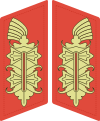General of the branch
A "general of the branch" or "general of the branch of service" is a rank equivalent to a three-star lieutenant general or four-star general. Several nations divide, or have once divided, their general officers by the branch of troops they are qualified to command, or simply as an honorific title.
Austria-Hungary

In the Austro-Hungarian Army there were three general of the branch ranks:
- General der Infanterie (en: General of the Infantry)
- General der Kavallerie (en: General of the Cavalry)
- Feldzeugmeister (en: General of the Artillery)
The rank of General der Infanterie was introduced in 1908, prior to this both infantrymen and gunners were appointed as Feldzeugmeisters.[1]
Historically, the rank of general of artillery (German: Feldzeugmeister; literally "battlefield ordnance master"; "gun master";[Note 1] in Hungarian Táborszernagy) was equivalent to lieutenant general.[2] In French, the equivalent expression was grand maitre d'artillerie, used since the time of Philip VI of France. The English position of Master-General of the Ordnance was similarly derived.
Bulgaria
The Third Bulgarian State from its inception in 1878 had a highest military rank of "general" (Bulgarian: генерал), but in 1897 this rank was split into three grades - general of infantry (генерал от пехотата), of cavalry (генерал от кавалерията) and of artillery (генерал от артилерията). The rank was replaced after World War II, when Bulgaria fell into the Soviet sphere of influence, with the all-encompassing rank of general.
Finland
Full generals (4 star; NATO OF-9) in the Finnish military were classified as generals of infantry (jalkaväenkenraali), cavalry (ratsuväenkenraali), jaeger (jääkärikenraali) and artillery (tykistönkenraali). The title is now merely honorific, and only one 4-star general is active at any one time in the modern Finnish military.
Germany
Wehrmacht
| General of the branch (shoulder insignia and gorget patches) |
 |
 |
 |
| Heer | Luftwaffe | Waffen-SS |
In the German Wehrmacht a General of a branch (German: General der Waffengattung) was linked to service arms of the Heer (army) and Luftwaffe (air force), depending on where the officer served and what troops he (nominally) commanded. It was equivalent to the three-star ranks of admiral in the Nazi Kriegsmarine, and SS-Obergruppenführer und General der Waffen-SS in the Waffen-SS. A commander-in-chief (Kommandierender General or Befehlshaber) of a German army corps was usually of this rank. In our time this rank might be comparable to NATO OF-8.
- Heer
- General of the artillery (German: General der Artillerie)
- General of the mountain troops (General der Gebirgstruppe)
- General of the Infantry (General der Infanterie)
- General of the cavalry (General der Kavallerie)
- General of the communications troops (General der Nachrichtentruppe)
- General of the panzer troops (General der Panzertruppe)
- General of the engineers (General der Pioniere)
- General of the medical corps (Generaloberstabsarzt)
- General of the veterinary corps (Generaloberstabveterinär)
- Sequence of ranks ascenting
| junior rank: Generalleutnant |
(German officer rank) |
senior rank: Generaloberst |
- Luftwaffe
- General of the parachute corps (General der Fallschirmtruppe)
- General of the anti-aircraft artillery (General der Flakartillerie)
- General of the aviators (General der Flieger)
- General of the air force communications corps (General der Luftnachrichtentruppe)
- General of the air force (General der Luftwaffe)
- Waffen-SS
- SS-Obergruppenführer and general of the Waffen-SS (SS-Obergruppenführer und General der Waffen-SS)
Bundeswehr
When the contemporary German Army, the Bundeswehr, was founded (on November, the 12th 1955) some of the names for general ranks were replaced with the current ones.
The denomination General der Panzertruppen, General der Infanterie, General der Artillerie and General der Fernmeldetruppe are still round, but they are not longer ranks but positions. These positions seem to roughly correspond to the pre-Bundeswehr Inspekteur der …. For example Heinz Guderian had the position of Inspekteur der Panzertruppen for a while.
Poland
In the Polish armed forces the rank equivalent to lieutenant general is generał broni ("general of a branch").[Note 2]
Russian Empire

Peter the Great created the ranks of general of infantry and general of cavalry in the Imperial Russian Army in 1699.
See also
- Comparative military ranks of World War I
- Comparative officer ranks of World War II
Notes
- The term is German. Feld- means battlefield, as used in the German Feldmarschall ("field marshal"), and -zeug- refers to the guns used by the artillery
- Polish broń means both "weapons, firearms" and "branch of troops"; in this context the meaning is clearly "general of a branch of troops", not "general of weapons"
References
- Herwig, Holger (1997). The First World War: Germany and Austria-Hungary 1914-1918. Arnold. p. 37. ISBN 9780340573488. Retrieved 27 June 2018.
- Lackey, Scott (1995). The Rebirth of the Habsburg Army: Friedrich Beck and the Rise of the General Staff [Issue 161 of Contributions in Military Studies]. ABC-CLIO. p. 1. ISBN 0313031312.